P.A. Peirson's Blog
October 18, 2014
Haunted History: Stetson, California
Dedicated in the Year of Our Lord 1893In memory of those who perished by fire on this land.Having suffered a terrible and unjust death, may these souls find their way to God.†Dare not to disturb these dead.

What happens when you disturb those who are best left alone? Stetson, California, may well find out.
Stetson is a sleepy little neighborhood rubbing shoulders with the hills of the San Fernando Valley. The whole thing is a rare remnant of the valley’s early farm and ranching days. Most lots have been reduced to dirt, their buildings leveled and land stripped, waiting for developers.
 San Fernando ValleyLike many parts of southern California, Stetson once belonged to a sprawling Spanish ranch. In 1798, Eduardo Luís Espadillo, the ranch’s first don, showed up with a land grant in hand bearing the King of Spain’s seal and signature. Despite protests of the local mission padres, Espadillo treated the native people like slaves, and his brutality became legendary. Thus, he enjoyed all the power and prestige of the landed gentry, farming the willing land; raising a large family and vast herds of cattle with equal ease; living and dying under the warm Western sun. For him and his family, life was good and just.
San Fernando ValleyLike many parts of southern California, Stetson once belonged to a sprawling Spanish ranch. In 1798, Eduardo Luís Espadillo, the ranch’s first don, showed up with a land grant in hand bearing the King of Spain’s seal and signature. Despite protests of the local mission padres, Espadillo treated the native people like slaves, and his brutality became legendary. Thus, he enjoyed all the power and prestige of the landed gentry, farming the willing land; raising a large family and vast herds of cattle with equal ease; living and dying under the warm Western sun. For him and his family, life was good and just. Then Spain’s grip on Mexico slipped, and in 1846, Mexico lost the land north of the Rio Grande. By this time, Rancho Espadillo was in the hands of Luis’ grandson, Vicente Gabriel. It seemed the height of good fortune when the madness of gold brought thousands to seek their fortune in the gold fields of California. The ranch prospered, shipping beef north to feed the hordes of ‘49ers pouring into the new territory. But, just like the Gold Rush, that prosperity was short-lived. The miners moved on or went home and the cattle boom went bust. Don Vicente, with the help of his son-in-law, Juan Adolfo Serrano, held on for awhile, turning from cattle to sheep—a smart move until the sheep market collapsed. Then, like vultures, the creditors moved in, and the Espadillo ranch, like all the others throughout the territory, was purchased and broken up into small farms and ranches owned by gringos. Slowly the Spanish speaking population was driven from the valley. The few that remained led poor, wretched lives.
One parcel of former Espadillo land was this pocket of the valley I now call home. Over the next few decades, it reverted to a sleepy, backwater region where nothing much happened and little changed. Then the township of Stetson was established.
Stetson was the brainchild of Thomas Winslow, a combined religious zealot, socialist, and Virginia chicken farmer who dreamed of establishing a pious, self-sustaining commune of like-minded devotees. Everyone would raise chickens, do a little farming, live off the land, and maybe conduct a bit of commerce on the side, selling eggs and fresh produce. So, in spring of 1892, Thomas, his wife Eva, and twelve families loaded their belongings onto carts and wagons then rail cars and made the arduous journey West, arriving in California just before winter’s first blizzards hit the Sierras.

Winslow’s utopian chicken farm cooperative did well, thriving for nearly five decades. But with the close of World War II, a cancer spread throughout the entire San Fernando Valley. Tract housing moved in, eating up the open land until little was left of the rural life. Shopping centers, strip malls, apartment mazes, and industrial parks crowded in where simple ranches, dairy farms, grazing land, orange orchards, and wheat fields had once stretched.
Stetson caught the disease, but the little community died slowly, with its final gasp literally in 1986. Delia Davies—last descendent of an original commune family—took a faltering breath and died while reading her bible one evening in February. She left no family and had no heirs. Her land went to auction, then sat idle for years. The neat rows of chicken houses sagged with weather rot and age. Her tiny home was boarded up.
Well, it was next to this relic of Stetson’s past that I took up residence a couple of years ago. However, its history, as I knew it, didn’t explain why it felt so creepy to walk the grounds, or why the lot was shunned by neighborhood animals and children alike.
Thank goodness for dusty old historical accounts. Further research turned up that when the Spanish took over the area, there were still some Native American villages. One was right here in Stetson. When Don Espadillo showed up to lay claim the land, the people said, ‘Go away. It is ours. We live here, we farm the land to feed our families, etc.’ Espadillo said, ‘Fine; no problem,’ and left. Three nights later, the village burned to the ground. No survivors.
There were one hundred twenty-seven souls lost in that fire. Espadillo organized a mass burial of the remains, then marked it with a little fence and a headstone. That’s as far as his conscience took him.
It seems he was a good judge of land. Anything he planted grew. The difficulties cropped up—pardon the pun—around harvest time. The locals still knew their history and wouldn’t come near the place. Superstitious. So, it was hard to find laborers to work the fields and orchards.
By the time Thomas Winslow got his cooperative going, much of that history was forgotten, and the fence and marker had disappeared. I imagine it was quite a shock when Delia’s grandpa unearthed the headstone. Well, he started asking around and found an old timer who’d heard the tale from his granddaddy. When Delia’s grandma found out, being a good Christian woman, she insisted that the area where the marker was found be set aside, consecrated, and never used. The oak was already there—maybe planted by Espadillo. So, Delia’s grandma had a metal marker made up and nailed to the tree, where it couldn’t be lost or buried again. It read:Dedicated in the Year of Our Lord 1893In memory of those who perished by fire on this land.Having suffered a terrible and unjust death, may these souls find their way to God.†Dare not to disturb these dead.
Last week, J.S. & Sons Construction put up signs on the chain link fence around the property. Someone’s planning on doing some building, and they’ll clear the land for starters. Makes you wonder what trouble they could possibly stir up. I’ll keep you posted.
 Stetson, California, is the setting for “The Lot on Winslow Street” a new ghost story in Tales from the Dead of Night II, due out in 2015.
Stetson, California, is the setting for “The Lot on Winslow Street” a new ghost story in Tales from the Dead of Night II, due out in 2015.
Published on October 18, 2014 23:51
Haunted Town of Stetson, California

What happens when you disturb something uncanny best left alone?
Stetson is a sleepy little neighborhood rubbing shoulders with the hills of the San Fernando Valley. The whole thing is a rare remnant of the valley’s early farm and ranching days. Most lots have been reduced to dirt, their buildings leveled and land stripped, waiting for developers.
 San Fernando ValleyLike many parts of southern California, Stetson once belonged to a sprawling Spanish ranch. In 1798, Eduardo Luís Espadillo, the ranch’s first don, showed up with a land grant in hand bearing the King of Spain’s seal and signature. Despite protests of the local mission padres, Espadillo treated the native people like slaves, and his brutality became legendary. Thus, he enjoyed all the power and prestige of the landed gentry, farming the willing land; raising a large family and vast herds of cattle with equal ease; living and dying under the warm Western sun. For him and his family, life was good and just.
San Fernando ValleyLike many parts of southern California, Stetson once belonged to a sprawling Spanish ranch. In 1798, Eduardo Luís Espadillo, the ranch’s first don, showed up with a land grant in hand bearing the King of Spain’s seal and signature. Despite protests of the local mission padres, Espadillo treated the native people like slaves, and his brutality became legendary. Thus, he enjoyed all the power and prestige of the landed gentry, farming the willing land; raising a large family and vast herds of cattle with equal ease; living and dying under the warm Western sun. For him and his family, life was good and just. Then Spain’s grip on Mexico slipped, and in 1846, Mexico lost the land north of the Rio Grande. By this time, Rancho Espadillo was in the hands of Luis’ grandson, Vicente Gabriel. It seemed the height of good fortune when the madness of gold brought thousands to seek their fortune in the gold fields of California. The ranch prospered, shipping beef north to feed the hordes of ‘49ers pouring into the new territory. But, just like the Gold Rush, that prosperity was short-lived. The miners moved on or went home and the cattle boom went bust. Don Vicente, with the help of his son-in-law, Juan Adolfo Serrano, held on for awhile, turning from cattle to sheep—a smart move until the sheep market collapsed. Then, like vultures, the creditors moved in, and the Espadillo ranch, like all the others throughout the territory, was purchased and broken up into small farms and ranches owned by gringos. Slowly the Spanish speaking population was driven from the valley. The few that remained led poor, wretched lives.
One parcel of former Espadillo land was this pocket of the valley I now call home. Over the next few decades, it reverted to a sleepy, backwater region where nothing much happened and little changed. Then the township of Stetson was established.
Stetson was the brainchild of Thomas Winslow, a combined religious zealot, socialist, and Virginia chicken farmer who dreamed of establishing a pious, self-sustaining commune of like-minded devotees. Everyone would raise chickens, do a little farming, live off the land, and maybe conduct a bit of commerce on the side, selling eggs and fresh produce. So, in spring of 1892, Thomas, his wife Eva, and twelve families loaded their belongings onto carts and wagons then rail cars and made the arduous journey West, arriving in California just before winter’s first blizzards hit the Sierras.

Winslow’s utopian chicken farm cooperative did well, thriving for nearly five decades. But with the close of World War II, a cancer spread throughout the entire San Fernando Valley. Tract housing moved in, eating up the open land until little was left of the rural life. Shopping centers, strip malls, apartment mazes, and industrial parks crowded in where simple ranches, dairy farms, grazing land, orange orchards, and wheat fields had once stretched.
Stetson caught the disease, but the little community died slowly, with its final gasp literally in 1986. Delia Davies—last descendent of an original commune family—took a faltering breath and died while reading her bible one evening in February. She left no family and had no heirs. Her land went to auction, then sat idle for years. The neat rows of chicken houses sagged with weather rot and age. Her tiny home was boarded up.
Well, it was next to this relic of Stetson’s past that I took up residence a couple of years ago. However, its history, as I knew it, didn’t explain why it felt so creepy to walk the grounds, or why the lot was shunned by neighborhood animals and children alike.
Thank goodness for dusty old historical accounts. Further research turned up that when the Spanish took over the area, there were still some Native American villages. One was right here in Stetson. When Don Espadillo showed up to lay claim the land, the people said, ‘Go away. It is ours. We live here, we farm the land to feed our families, etc.’ Espadillo said, ‘Fine; no problem,’ and left. Three nights later, the village burned to the ground. No survivors.
There were one hundred twenty-seven souls lost in that fire. Espadillo organized a mass burial of the remains, then marked it with a little fence and a headstone. That’s as far as his conscience took him.
It seems he was a good judge of land. Anything he planted grew. The difficulties cropped up—pardon the pun—around harvest time. The locals still knew their history and wouldn’t come near the place. Superstitious. So, it was hard to find laborers to work the fields and orchards.
By the time Thomas Winslow got his cooperative going, much of that history was forgotten, and the fence and marker had disappeared. I imagine it was quite a shock when Delia’s grandpa unearthed the headstone. Well, he started asking around and found an old timer who’d heard the tale from his granddaddy. When Delia’s grandma found out, being a good Christian woman, she insisted that the area where the marker was found be set aside, consecrated, and never used. The oak was already there—maybe planted by Espadillo. So, Delia’s grandma had a metal marker made up and nailed to the tree, where it couldn’t be lost or buried again. It read:Dedicated in the year of our Lord 1893In memory of those who perished by fire on this land.Having suffered a terrible and unjust death, may these souls find their way to God.†Dare not to disturb these dead.
Last week, J.S. & Sons Construction put up signs on the chain link fence around the property. Someone’s planning on doing some building, and they’ll clear the land for starters. Makes you wonder what trouble they could possibly stir up. I’ll keep you posted.
 Stetson, California, is the setting for “The Lot on Winslow Street” a new ghost story in Tales from the Dead of Night II, due out in 2015.
Stetson, California, is the setting for “The Lot on Winslow Street” a new ghost story in Tales from the Dead of Night II, due out in 2015.
Published on October 18, 2014 23:51
October 9, 2013
A Dead Queen's Strange Tomb
It seems that, even when dead, some women enjoy a spirited jest. Long after her death, Queen Nitocris of Babylon slapped the hand of a Persian king while serving up a lesson on greed. I first told this dark little tale on my blog Gryphon Gold. It seems equally at home here.
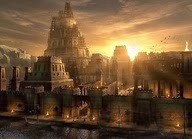 The glory days of Ancient BabylonThis mischievous lady was queen of Babylon in the 6th century BC. Daughter of famed King Nebuchadnezzar II, she was riding the crest of her power around 550 BC. At the time, she was married to Nabonidus, the last ruler of Babylon.
The glory days of Ancient BabylonThis mischievous lady was queen of Babylon in the 6th century BC. Daughter of famed King Nebuchadnezzar II, she was riding the crest of her power around 550 BC. At the time, she was married to Nabonidus, the last ruler of Babylon.In that same year, Cyrus the Great, king of Persia, was taking the first step towards carving out his empire by conquering the Median Empire. Next he would set his sights on the Lydian Empire and eventually the Neo-Babylonian.
Nitocris was both ambitious and clever. According to Herodotus, she implemented a number of diversions of the Euphrates, making it more difficult to navigate and improving its potential usefulness in defense of the city. She also had a stone bridge constructed that crossed the river, which cut the walled city in half. Herodotus also claimed that Nitocris ordered construction of an artificial lake basin outside the city. (Note: The site of the queen’s bridge has been uncovered by archaeologists.)
Perhaps the queen’s most memorable contribution to history was her tomb. Wishing to perpetuate her name after death, she had arranged for her tomb to be built above one of the many gates of Babylon. Engraved on the outside of it was an inscription that said in essence: If one of the rulers of Babylon after me is in want of money, let him open my tomb and take however much he likes. But if he is not in need, he should beware and under no circumstances open it.
Babylon fell under Persian rule in 539 BC. The queen’s tomb went undisturbed until Darius the Great came to the city (around 520 BC).
According to Herodotus, the tomb was a source of tremendous aggravation for Darius. First, its epitaph was tantalizing and encouraged its plunder. Second, Darius could not walk under the gate because he could not walk under a corpse. Finally, he ordered the tomb to be opened so that he might take possession of Queen Nitocris’ treasure.
Imagine his annoyance at finding nothing but the body of the dead queen and this finger-wagging rebuke: If you had not been insatiable after gold and eager for shameful gain, you would never have violated the asylum of the dead.
The clever queen had the last word and, if she was still hanging around in spirit, a good laugh.
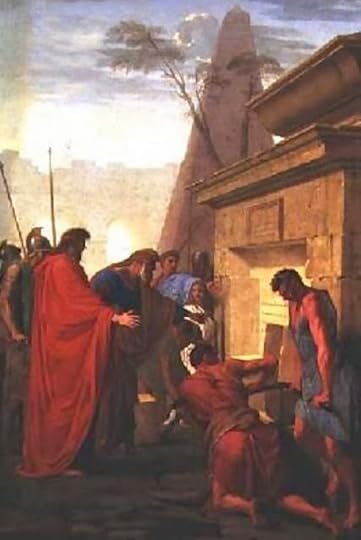 Not even the ghost of of a treasure
Not even the ghost of of a treasure Happy Hauntings!
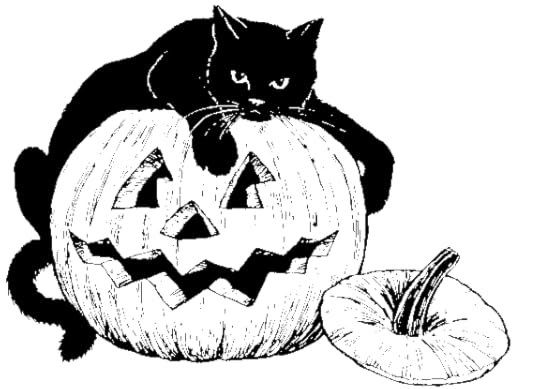
Published on October 09, 2013 15:15
October 18, 2012
The Haunting Life & Death of Edgar Allan Poe
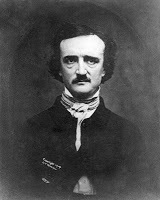 Poe daguerreotype
Poe daguerreotype "There are moments when, even to the sober eye of Reason, the world of our sad Humanity may assume the semblance of a Hell... Alas! the grim legion of sepulchral terrors cannot be regarded as altogether fanciful… they must sleep, or they will devour us—they must be suffered to slumber, or we perish." (from The Premature Burial by Edgar Allen Poe)
In rare cases, no post mortem appearances are required to forever link an individual to that World Beyond the Grave. Even in Life, he (or she) seems to be an intimate of Death—not just the Idea, but that dreadful, dark Being who hunts us all.
Of course, I’m speaking of Edgar Allan Poe, who gave Death a form and face in haunting tales like The Masque of the Red Death.
In this chilling story, Death makes an appearance amidst the torch-lit, barbaric splendor of a nightmarish masked ball. Secure behind the walls of his castellated abbey, a prince and the privileged hold their bizarre and magnificent revel, while pestilence ravages the populace without. But Death will not be denied. Tall, gaunt and wearing the ghastly face of a stiffened corpse, he enters as a guest, with inescapable consequences:
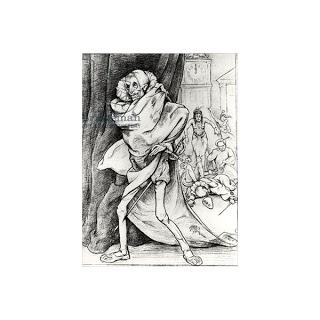 “And now was acknowledged the presence of the Red Death. He had come like a thief in the night. And one by one dropped the revelers in the blood-bedewed halls of their revel, and died each in the despairing posture of his fall. And the life of the ebony clock went out with that of the last of the gay. And the flames of the tripods expired. And Darkness and Decay and the Red Death held illimitable dominion over all.”
“And now was acknowledged the presence of the Red Death. He had come like a thief in the night. And one by one dropped the revelers in the blood-bedewed halls of their revel, and died each in the despairing posture of his fall. And the life of the ebony clock went out with that of the last of the gay. And the flames of the tripods expired. And Darkness and Decay and the Red Death held illimitable dominion over all.”What an image!
On October 07, 1849, Poe took a final walk with Death. He was only 40 years old. Four days earlier, he’d been found outside a Baltimore, Maryland, tavern, disheveled, delirious, and in dire need of medical help. Though theories abound, the actual cause of his condition and subsequent demise remains a mystery. Equally uncertain are the days leading up to his mortal illness. Here are some of the puzzling details:
· Poe leaves Richmond, VA, on September 27, arriving in Baltimore on September 28.· His movements and whereabouts over the next few days are shrouded in mystery, even for his Baltimore cousin, Neilson Poe.· Separate reports claim that Poe was carrying a sum of money ranging from a small amount to as much as $1,500. As no money was found on him, some people speculate that he was mugged.· When Poe was found by Joseph W. Walker on October 3rd, 1849, outside of Gunner’s Hall, his clothing had been changed. In place of his customary, tasteful suit of black wool was one of cheap gabardine, faded and stained. He was also wearing an uncharacteristic and decrepit palm leaf hat. · Poe was taken to Washington College Hospital, where he lapsed in and out of consciousness, unable to reveal the cause of his condition.· His last words, according to John J. Moran (author of A Defense of Edgar Allan Poe, 1885), were “Lord help my poor soul.”· Poe died on October 7th.· The Baltimore Clipper reports Poe’s death rather oddly, stating cause of death as “congestion of the brain.” No one is certain what that means specifically.· No death certificate seems to have been filed.· Poe was buried in the Old Western Burial Ground in Baltimore, next to his young wife, Virginia Eliza Clemm Poe.
 Poe's beloved wife, Virginia, dead at age 24
Poe's beloved wife, Virginia, dead at age 24Whatever the cause, Poe’s death was tragic, pointless, and a loss to the world.
 Quoth the Raven, "Nevermore."As an author, Edgar Allan Poe profoundly influenced literature. His genius transformed the short story from simple anecdote into works of skill and imagination. He’s credited with inventing the detective story and modern mystery with such tales as “The Murders in the Rue Morgue” and “The Purloined Letter.” As an early pioneer of science fiction, he often threaded his writing with the scientific theories of the day. He was also a poet, weaving hauntingly romantic elegies such as “Annabel Lee” and conjuring unforgettable scenes of terror in works like “The Raven.”
Quoth the Raven, "Nevermore."As an author, Edgar Allan Poe profoundly influenced literature. His genius transformed the short story from simple anecdote into works of skill and imagination. He’s credited with inventing the detective story and modern mystery with such tales as “The Murders in the Rue Morgue” and “The Purloined Letter.” As an early pioneer of science fiction, he often threaded his writing with the scientific theories of the day. He was also a poet, weaving hauntingly romantic elegies such as “Annabel Lee” and conjuring unforgettable scenes of terror in works like “The Raven.” But, of course, above all, Poe was a horror writer, drawing the reader into gothic realms where the rational mind encounters its most irrational, atavistic fears. Here the dead return and the living die grotesquely or, worse, are entombed alive. Death stalks the land, animate, dreadful, and merciless. Madness and despair among the living often follow in his wake. Surely, to craft such tales, Poe had to draw on his own wild and desperate fears, personal tragedies, and private demons.
So, here’s to a literary great who lives on through his work. R.I.P. Mr. Poe. I hope that you’ve found the answers and rest that you seemed to seek.
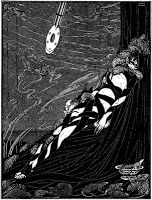 The Pit and the Pendulum by Clarke"And then there stole into my fancy, like a rich musical note, the thought of what sweet rest there must be in the grave." The Pit and the Pendulum
The Pit and the Pendulum by Clarke"And then there stole into my fancy, like a rich musical note, the thought of what sweet rest there must be in the grave." The Pit and the PendulumFor more fascinating insights about Poe, be sure to visit the Edgar Allan Poe Society of Baltimore www.eapoe.org
If you happen to be in Baltimore, check out the society’s “Halloween at the Poe Grave” on October 31st. Who knows who you’ll encounter. As Poe said, “The boundaries which divide Life from Death are at best shadowy and vague. Who shall say where the one ends, and where the other begins?”
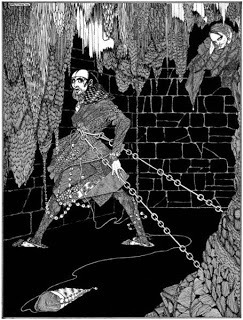 "A succession of loud and shrill screams, bursting suddenly from the throat of the chained form, seemed to thrust me violently back. For a brief moment--I trembled." The Cask of Amontillado
"A succession of loud and shrill screams, bursting suddenly from the throat of the chained form, seemed to thrust me violently back. For a brief moment--I trembled." The Cask of AmontilladoHappy Hauntings, eveyone!

Published on October 18, 2012 14:50
September 2, 2012
Winchester Mystery House™: Sarah Winchester, RIP
September 5, 2012, marks the 90th anniversary of Sarah Winchester’s passing. Creator of the most splendidly bizarre house in the world—the Winchester Mystery House™—Sarah passed away peacefully (we hope) in her sleep in 1922. But her legacy lives on in a house that many visitors will swear is haunted.
 A rare photo of Sarah WinchesterBriefly for those of you unfamiliar with the story: In 1862, Sarah Lockwood Pardee, known as the “Belle of New Haven” (Connecticut), married wealthy William Wirt Winchester, son of Oliver Fisher Winchester, manufacturer of the famous Winchester repeating rifle (“the gun that won the West”). Life and marriage were blissful until the unexplained death of her infant daughter in 1866, followed by the untimely death of her husband fifteen years later.
A rare photo of Sarah WinchesterBriefly for those of you unfamiliar with the story: In 1862, Sarah Lockwood Pardee, known as the “Belle of New Haven” (Connecticut), married wealthy William Wirt Winchester, son of Oliver Fisher Winchester, manufacturer of the famous Winchester repeating rifle (“the gun that won the West”). Life and marriage were blissful until the unexplained death of her infant daughter in 1866, followed by the untimely death of her husband fifteen years later.Stricken with grief and depression, Sarah turned to a Boston spiritualist for relief and a possible explanation for these heart-rending misfortunes. Through the medium, it was revealed to her that the spirits of American Indians, Civil War soldiers, and others killed by Winchester rifles were behind these tragedies, and Sarah herself could be their next victim. However, there was a way to appease the angry spirits: move west and build them a great house. As long as construction continued, Sarah would be safe.Feeling haunted and hunted, Mrs. Winchester took the advice to heart, came to California, and found the perfect spot for her project in the Santa Clara Valley, just three miles west of San Jose. Beginning with an unfinished farm house that she purchased in 1844, she spent the next thirty-eight years overseeing the non-stop construction that produced the "eerily eccentric" Winchester Mystery House™—"an extravagant maze of Victorian craftsmanship."
 According to the official site for the Winchester Mystery House™ (www.winchestermysteryhouse.com): “At the time of her death, the unrelenting construction had rambled over six acres. The sprawling mansion contained 160 rooms, 2,000 doors, 10,000 windows, 47 stairways, 47 fireplaces, 13 bathrooms, and 6 kitchens. Carpenters even left nails half driven when they learned of Mrs. Winchester’s death.”
According to the official site for the Winchester Mystery House™ (www.winchestermysteryhouse.com): “At the time of her death, the unrelenting construction had rambled over six acres. The sprawling mansion contained 160 rooms, 2,000 doors, 10,000 windows, 47 stairways, 47 fireplaces, 13 bathrooms, and 6 kitchens. Carpenters even left nails half driven when they learned of Mrs. Winchester’s death.”

With miles of twisting hallways, secret passageways, staircases to nowhere, doors and windows that lead to unexpected places, not to mention the famously spooky Séance Room, the wild, weird, and fanciful Winchester Mystery House™ is a must see and a memorable experience.There’s so much more to this fascinating story, and the official site has done a stellar job laying it all out for you (www.winchestermysteryhouse.com). I’ve toured the house myself, and I would gladly return. Admittedly, I encountered no ghosts, but like so many history-haunted places, it’s the stories behind the location that make the impression and linger on in memory. Besides, there are plenty of people who have had a ghostly experience and will swear the house is haunted. You’ll find their strange tales on the website, also.
Sarah Winchester is buried at the Evergreen Cemetery in New Haven, Connecticut, beside her beloved husband. RIP
For the rest of you -- Happy Hauntings!
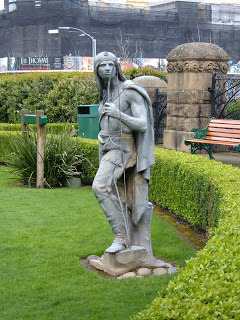
Published on September 02, 2012 15:59
August 18, 2012
History Haunted Pompeii: In the Shadow of Vesuvius
On August 24, AD 79 -- nineteen hundred and thirty-three years ago -- Mount Vesuvius roused itself from a long sleep and erupted. In the space of 42 hours, the thriving Roman seacoast town of Pompeii was buried under a 23-foot layer of volcanic ash and lapilli. Other towns for miles around, famously including Herculaneum, were wiped out, too. The landscape was changed forever and, in time, Pompeii herself was forgotten. But she guarded her secrets well, preserving them until 1748 when a pickax strike broke through her stone shroud. Our understanding of everyday life in ancient Rome changed forever.
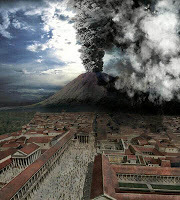
As it happens, I’m finishing up an excellent NY Times bestseller by Robert Harris titled “Pompeii.” He’s an exceptionally good storyteller, and his approach to the town’s last days is exciting, beautifully researched, intelligent, and wonderfully imagined. I highly recommend it.
Reading “Pompeii” also drew me back to my own unforgettable visit to the town many years ago. I’d been traveling around Europe auditioning for ballet companies. The audition season fell late in the year with a hiatus during the Christmas holiday, and being lonely and bored, decided to make good use of my Eurail Pass, jump on a train, and head south for Rome. No plan; just a whim.
It was the perfect time of year to visit: mild weather and only a handful of tourists. I met one—a girl from Chicago—while exchanging deutsch marks for lira, and after a month on my own, hearing and speaking (poorly) mostly German, it was wonderful to chat with someone from home. She’d been on her own for awhile, too, so we decided to hang out and see Rome together.
 After an intoxicating day of tramping around the Eternal City, we decided to visit Pompeii. So, early the next day, we set out, arriving by mid-morning. The sky was slightly overcast, the weather cool, and luck had smiled on us—Pompeii was utterly deserted. In fact, at the entrance to the ruins, we met the only other visitors that day: a history professor from Texas college and his wife. Pompeii was their passion; they knew her treasures and secrets inside and out.
After an intoxicating day of tramping around the Eternal City, we decided to visit Pompeii. So, early the next day, we set out, arriving by mid-morning. The sky was slightly overcast, the weather cool, and luck had smiled on us—Pompeii was utterly deserted. In fact, at the entrance to the ruins, we met the only other visitors that day: a history professor from Texas college and his wife. Pompeii was their passion; they knew her treasures and secrets inside and out.So, for the rest of the day, my friend and I enjoyed a guided tour of the ruins. The professor knew exactly where an excavated room or courtyard displayed an awesomely preserved fresco or a beautiful fountain. He knew where to find 2000 year old graffiti and what it said, and could tell us what vendors had sold in this or that shop, the purpose of this or that public building or temple, and so on.
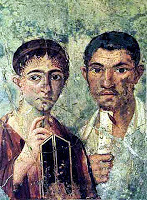 What I never forgot was the silence of Pompeii. It is truly a city of the dead. Two-thousand people—15 per cent of the town’s entire population—were suffocated or burned to death by the hot gases and ash that enveloped the town on August 25. A final discharge of pyroclastic material finished the job, engulfing the walls and burying victims. Today, the wind slipping through the gaping doors and windows gives occasional voice, but that is all. There is a sadness about the place. A solemnity.
What I never forgot was the silence of Pompeii. It is truly a city of the dead. Two-thousand people—15 per cent of the town’s entire population—were suffocated or burned to death by the hot gases and ash that enveloped the town on August 25. A final discharge of pyroclastic material finished the job, engulfing the walls and burying victims. Today, the wind slipping through the gaping doors and windows gives occasional voice, but that is all. There is a sadness about the place. A solemnity. Oddly, no one has seriously claimed that Pompeii is haunted. You would think that a site of sudden, violent, and tragic death on such a large scale would be. To touch the warm temple stones, walk streets that were buried for centuries, peer into shops, homes, and garden, or gaze upon exquisitely preserved painting, portraits, mosaics and bronzes is to touch the past. Close your eyes and reach for it. It seems so near, just beyond Time’s veil. Yet, Pompeii is only haunted by its history, not the souls of the dead; haunted by what happened within a span of two days and its preserved visions of daily life flash-frozen in volcanic debris.
Oddly, no one has seriously claimed that Pompeii is haunted. You would think that a site of sudden, violent, and tragic death on such a large scale would be. To touch the warm temple stones, walk streets that were buried for centuries, peer into shops, homes, and garden, or gaze upon exquisitely preserved painting, portraits, mosaics and bronzes is to touch the past. Close your eyes and reach for it. It seems so near, just beyond Time’s veil. Yet, Pompeii is only haunted by its history, not the souls of the dead; haunted by what happened within a span of two days and its preserved visions of daily life flash-frozen in volcanic debris.  Now I smile with one last memory—a surreal moment while sitting high up in the stone seats of Pompeii’s vast amphitheatre, looking out across the arena to gaze at distant Mt. Vesuvius. (The town’s amphitheatre is the oldest known building designed for gladiatorial games.) My friend and I had not thought to bring along food for the excursion, but the professor and his wife had come wonderfully prepared and were delighted to share. So, in the presence of that sleeping volcano, surrounded by a city that never left the first century AD, we four tore soft chunks of bread from fat, round, freshly-baked Italian loaf and smeared it with American peanut-butter. Bless his heart, the professor never traveled without it! It tasted marvelous.
Now I smile with one last memory—a surreal moment while sitting high up in the stone seats of Pompeii’s vast amphitheatre, looking out across the arena to gaze at distant Mt. Vesuvius. (The town’s amphitheatre is the oldest known building designed for gladiatorial games.) My friend and I had not thought to bring along food for the excursion, but the professor and his wife had come wonderfully prepared and were delighted to share. So, in the presence of that sleeping volcano, surrounded by a city that never left the first century AD, we four tore soft chunks of bread from fat, round, freshly-baked Italian loaf and smeared it with American peanut-butter. Bless his heart, the professor never traveled without it! It tasted marvelous.In addition to these memories, I have one precious souvenir from that incredible day—a tiny cube of marble that once may have graced a mosaic. As we four strolled through the ruins, the professor spied it, picked it up, and gave it to me. Perhaps I shouldn’t have kept it, but I did and treasure it still. It’s my small connection to history-haunted Pompeii, and I hope, like a good luck charm, it will someday bring me back to her for another visit.

Published on August 18, 2012 00:44
July 2, 2012
Ghost Pictures? History-Haunted Whaley House
More haunted history around San Diego, California.
In 1850, the newly-formed county of San Diego boasted a population of 798 living souls—a far cry from the nearly 3 million in residence today. By 1852, the first ghost of note was in the process of becoming.
 Prosecutor James W. RobinsonJames Robinson a.k.a. Santiago Robinson a.k.a. Yankee Jim had plotted to steal a pilot boat—or so the court ruled. Yankee Jim was not exactly a model citizen. Reportedly, he had come to San Diego a year earlier to escape some problems in a northern mining camp. When he was caught in rowboat too close to the schooner Plautus in San Diego harbor, things went hard for him. He was convicted of attempted theft of the boat and sentenced to death. For reasons unknown, his accomplices were let off. Oddly enough, so the story goes, Jim's prosecutor shared his name.
Prosecutor James W. RobinsonJames Robinson a.k.a. Santiago Robinson a.k.a. Yankee Jim had plotted to steal a pilot boat—or so the court ruled. Yankee Jim was not exactly a model citizen. Reportedly, he had come to San Diego a year earlier to escape some problems in a northern mining camp. When he was caught in rowboat too close to the schooner Plautus in San Diego harbor, things went hard for him. He was convicted of attempted theft of the boat and sentenced to death. For reasons unknown, his accomplices were let off. Oddly enough, so the story goes, Jim's prosecutor shared his name.Poor Jim. His troubles did not stop there. As the story goes, the gallows from which he was hung were built for a man of regular height. Yankee Jim was quite a bit taller, so when the wagon was pulled out from under him, his feet brushed the ground and his neck failed to snap. He strangled to death, instead. Another story claims that the rope was too long, but the effect was the same—strangulation. It’s worth noting that he died proclaiming his innocence. In addition to these oddities, apparently the executioner was his godfather, Sheriff William Crosswaithe.
A few years later, the site of Yankee Jim’s demise became the archway between the music room and parlor of one of the most haunted houses in the United States: the Whaley House. Though the owner, Thomas Whaley, was a spectator at Jim’s hanging, that fact does not appear to have troubled him when contructing his beautiful new home around the gallow’s former location.
Now that begs the question: Did the tragic event of 1852 set the stage for future tragedies and the haunting of the Whaley House? Though, like most homes, the Whaley House witnessed periods of familial joy and contentment, it also was the scene of great sadness and suffering.
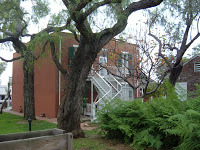 Whaley House: View from garden Thomas and his wife, Anna, moved into their new Greek Revival-style residence in August, 1857. On January 29, 1858, their third child, Thomas Whaley, Jr., died from scarlet fever. He was just 18 months old.
Whaley House: View from garden Thomas and his wife, Anna, moved into their new Greek Revival-style residence in August, 1857. On January 29, 1858, their third child, Thomas Whaley, Jr., died from scarlet fever. He was just 18 months old. Disaster soon followed tragedy. Located within the family home was Mr. Whaley’s general store—a successful venture until destroyed by fire shortly after baby Thomas’ death. Thankfully, no one was hurt, but the Whaleys moved to San Francisco for a time. They returned to San Diego 10 years later.
The Whaley House must have been the scene of happiness on January 5, 1882. Two of the Whaley daughters—Violet Eloise and Anna Amelia—had just been married in Old San Diego. However, Violet’s joy was short-lived. During her honeymoon, she awoke one morning to find that her husband had vanished. The young bride had been the victim of a con artist interested only in the substantial dowry that he believed he would collect. Violet returned home to live, humiliated and shunned by “polite society” who deemed somehow that she was a tarnished woman. Depressed and tired of life, she took her own life with a 32-calibre gun on August 18, 1885. She was only 22.
The scandal of Violet’s death had its own repercussions. Her sister, Corrine Lillian, was engaged at the time of the suicide, but her fiance could not bear the associated shame of it, so broke off the engagement.
Perhaps seeking to escape the cloud of tragedy that had settled over their home, the Whaleys moved to a house built by Thomas in Downtown San Diego. For more than two decades the Whaley House stood vacant and neglected.
Thomas Whaley died in 1890. In 1909, his son Francis decided to restore and reopen Whaley House as a tourist attraction. By 1912, it was also home again to his mother Anna, sister Corrine Lillian, brother George, and Francis himself. However, it did not take long for Death to again visit the family. On February 24, 1913, Anna died (age 80); Francis a year later, on November 19.
For a time, Death took a holiday . Then, on January 5, 1928, George Whaley died, leaving Corrine Lillian to live out her life seemingly alone in the house until her death in 1953.
It’s not surprising to find that the Whaley House is haunted. Ghost hunters, docents, and visitors to the landmark have experienced a variety of ghostly manifestations from apparitions and the feeling of being watched, to footsteps, rappings, strange smells, cold spots, the sense of being touched, and so on. Even the United States Chamber of Commerce has declared the house to be genuinely haunted.
To this I will add my own experience. While visiting the Whaley House back in 2005, I took numerous digital photos, expecting to capture nothing in particular; just pics of the interior. When I took a look later, however, I found two images of particular interest. The first was that taken of Mr. Whaley’s study. There is cane propped against the desk that, supposedly, is actually his. Note the round blue ball just near the cane’s handle. I’ve seen many pictures of dust orbs, but never one so opaque or so blue. I don’t know. It’s curious.
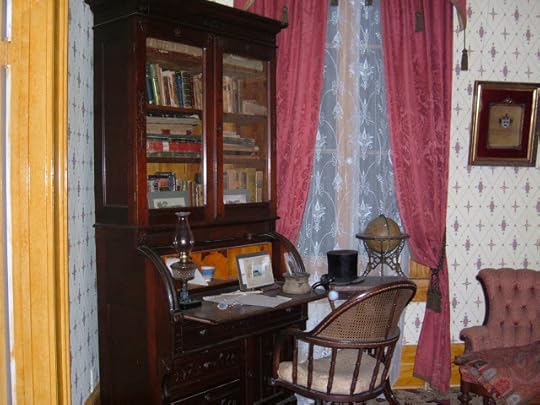
The other is a bit more difficult to see on a small scale, but in this photo, on the right side of the table, towards the center and near the edge, there is something that almost looks like smoke rising from the table. It’s my understanding that a child died after consuming something poisonous in that room. Again, I can’t say for sure what I’ve captured, but I will say that I’ve taken several hundred photos with that camera, and I’ve caught nothing like this before or after. Subtle, but strange.
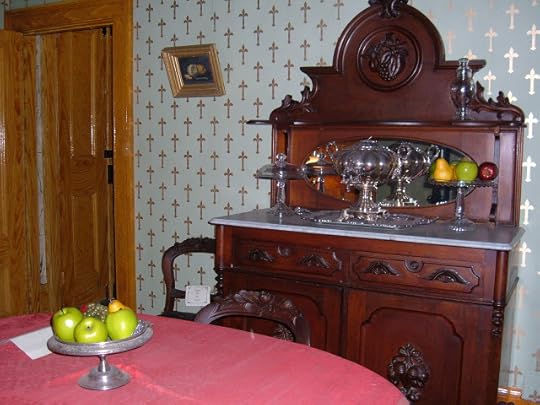
Let me know what you think.
Happy Hauntings!
Published on July 02, 2012 13:25
June 21, 2012
The Nosey Ghost: A Poem by DEAN FARNELL
Just for fun, here's another ghostly tale by poet and songwriter Dean Farnell:
The nosey old woman's obsessed
She loved to just snoop and to spy.
She decided to take her own life
This is the reason why.
She had the idea as a ghost
An invisible spirit she'd be.
She could peer into everyone's world
Watch things no-one else could see.
Her life she had lived was spent
Interfering and giving advice.
She's happy, the nosey old ghost
But paying the ultimate price.
Each day she does roam, all on her own
Listening to everyone's stress.
Her dreams have come true, just watching you
The arguments she loves the best.
She's probably there in your room
Just sat on your opposite chair.
I know you can't help but peek
She's watching, so just be aware.
[image error]
About Dean:
Quirky Songwriter and Horror Writer with original songs and poems which have been used in theme music on U.S. TV Radio stations, & Magazines, and one song has recently won an I.A.I.R.A. International Association of Independent Recording Artists Top 10 award.
Likes classic sci fi horror films and writing quirky songs and have had 14 indie chart no1 songs, have written various radio station jingles, and have appeared on many podcast/radio stations in the UK and USA. Current news is Ghost on the stairs, a track I've written is to feature in a new novel titled Rock & Roll ghost stories and songs feature in Ontology TV and The Late Night at the Horror Hotel & Suzie D.Rotts Warehouse of Terror TV shows also feature my songs. Horror poems now feature in top horror mags.
Thanks, again, Dean!
Happy Hauntings!

The nosey old woman's obsessed
She loved to just snoop and to spy.
She decided to take her own life
This is the reason why.
She had the idea as a ghost
An invisible spirit she'd be.
She could peer into everyone's world
Watch things no-one else could see.
Her life she had lived was spent
Interfering and giving advice.
She's happy, the nosey old ghost
But paying the ultimate price.
Each day she does roam, all on her own
Listening to everyone's stress.
Her dreams have come true, just watching you
The arguments she loves the best.
She's probably there in your room
Just sat on your opposite chair.
I know you can't help but peek
She's watching, so just be aware.
[image error]
About Dean:
Quirky Songwriter and Horror Writer with original songs and poems which have been used in theme music on U.S. TV Radio stations, & Magazines, and one song has recently won an I.A.I.R.A. International Association of Independent Recording Artists Top 10 award.
Likes classic sci fi horror films and writing quirky songs and have had 14 indie chart no1 songs, have written various radio station jingles, and have appeared on many podcast/radio stations in the UK and USA. Current news is Ghost on the stairs, a track I've written is to feature in a new novel titled Rock & Roll ghost stories and songs feature in Ontology TV and The Late Night at the Horror Hotel & Suzie D.Rotts Warehouse of Terror TV shows also feature my songs. Horror poems now feature in top horror mags.
Thanks, again, Dean!
Happy Hauntings!
Published on June 21, 2012 14:21
June 14, 2012
Greeks, Ghost Hunts, and the First Haunted House Story
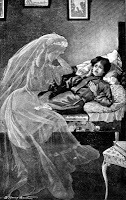
From ghoulies and ghosties
And long-leggedy beasties
And things that go bump in the night,
Good Lord, deliver us!
~Scottish Saying
Stories of ghosts, the spirit world, and things “that go bump in the night” are common threads found deeply woven into the historical and cultural fabric of most nations and people of the world. The earliest recorded story involving the supernatural is the Epic of Gilgamesh, a 4,000-year-old Sumerian saga describing the journey to the spirit world by a Mesopotamian Priest-King of the city of Uruk in his quest for immortality. To his despair, he finds that the gods retain this gift beyond price for themselves. This epic first set forth the notion that the gods shaped humankind from clay, then breathed into their nostrils the breath of life. In time, that “breath of life” has become the thing that survives corporeal death: the spirit.However, it’s Greeks that hold the prize for the first recorded tale that has all the trappings of the modern haunted house ghost story. Set down in a letter by Pliny the Younger (lawyer, an author and a natural philosopher of Ancient Rome) sometime during the last century B.C., the story takes place in Athens in a stately, deserted house with a “reputation for being unhealthy.” Hmm, sounds familiar…As the story goes, residents of the house were tormented night after night by the clamor of clanking chains. The unsettling din would grow louder and louder until the ghost of an emaciated, disheveled old man—shackled and chained—appeared. Eventually no one would stay in the house, and it was abandoned.One day, the Greek philosopher Athenodorus, intrigued by the story, rented the dwelling, determined to wait for the ghost’s appearance and to discover its purpose. I suppose he might be considered the original ghost hunter and this the first official ghost hunt. At any rate, late that night, as hoped, the clatter of chains began to sound throughout the house, growing ever closer until it filled the room where he waited. Then the decrepit apparition materialized … and beckoned.
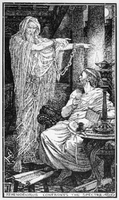 Stoically, Athenodorus followed. As the ghost reached an open area in the house, it suddenly disappeared. Quickly, Athenodorus marked the spot with a clump of grass. The following day, under the supervision of a local magistrate, the spot was dug up, revealing the shackled and chained skeletal remains of a man. So, as you can see, the concept of spirits that walk the Earth and interact with the living has a very old and well-established foundation. Humankind, since earliest antiquity, has believed in the existence of the unseen. Thousands of years of belief have been woven in our collective psyche, allowing for the acceptance (at the very least) of the possibility of ghosts and hauntings. Even the staunchest skeptic carries the seeds of belief. As Mark Twain reportedly once said, “I don’t believe in ghosts, but I am afraid of them.”Happy Hauntings!
Stoically, Athenodorus followed. As the ghost reached an open area in the house, it suddenly disappeared. Quickly, Athenodorus marked the spot with a clump of grass. The following day, under the supervision of a local magistrate, the spot was dug up, revealing the shackled and chained skeletal remains of a man. So, as you can see, the concept of spirits that walk the Earth and interact with the living has a very old and well-established foundation. Humankind, since earliest antiquity, has believed in the existence of the unseen. Thousands of years of belief have been woven in our collective psyche, allowing for the acceptance (at the very least) of the possibility of ghosts and hauntings. Even the staunchest skeptic carries the seeds of belief. As Mark Twain reportedly once said, “I don’t believe in ghosts, but I am afraid of them.”Happy Hauntings!
Published on June 14, 2012 22:38
June 4, 2012
HAUNTED SHIPS: THE STAR OF INDIA – PART III
Awhile back, I played with the idea of writing a “Haunted San Diego”-style book that emphasized historical settings and details as they related to specific hauntings and other supernatural phenomena. Though thatbook never materialized (see in its place Timeless Ghost Stories), all the research and first entries remained alive and well on my trusty computer. In this, my 3rdpost about The Star of India, I’ve been sharing what I learned about her haunted history, from collisions to mutiny and death, as they relate to the ghostly presences aboard her.
Beginning her life as a fully square-rigged ship christened Euterpe, The Star of India is the world's oldest seafaring ship and crown jewel of the Maritime Museum in San Diego, CA.

Part III—Changing Hands; Changing Name
Many of New Zealand’s families today can thank Euterpe for providing safe passage to their ancestors throughout the late 1800s. It was a hard journey. These brave sojourners spent a minimum of 100 days and as many as 142 aboard ship, battling hunger, ship rats, and each other; hazarding storm-lashed, mountainous seas that swept men from the deck into cold, churning waters in the blink of an eye; enduring shrieking gales that ripped sails to tatters and snapped yards like brittle sticks. Yet against the odds they survived. By some accounts, a baby was even born on one such trip en route to New Zealand and given the middle name Euterpe.
After 21 round trips, Euterpe’s service as an emigrant ship ended in 1897. She was sold, passed through several hands, and was finally acquired by the Alaska Packers’ Association in 1901. Re-rigged as a three-masted barque—the official designation for a ship with three or more masts, all square-rigged except the aftermast—she was used in the Alaskan salmon cannery industry.
For eleven springs, Euterpe set sail from Oakland, California, bound for the Bering Sea, and returned each fall with her holds full of canned salmon. It was during this time (1906) that she was re-christened Star of India.
And during this time, bad luck once again booked passage.
In the bow of the ship, an opening leads to the chain locker. It is into this storage area deep below deck that the thick, heavy anchor chain, or rode, is fed when the ship weighs anchor. Aboard the Star of India, raising and stowing the anchor required both muscle and machinery. Several crewmen would push on wooden bars set into a topside capstan, and this in turn set in motion machinery below decks.
It was spring, and Star of India was heading for the Alaskan salmon grounds. The command was given to weigh anchor, and the machinery ground into action, drawing up the anchor and feeding its massive iron chain into the locker. Above the scream of machinery and the echoing din of metal dropping away into the chamber, the screams of a Chinese crewman trapped in the locker were undetected. No one knew their crewmate was dying. The hapless seaman was slowly crushed to death.
Did this tragedy leave yet another lasting impression on the Star of India? Many visitors believe so. They report feeling a cold spot near the chain locker. What might be heard on a quiet night if you stood there for a time and just listened?
A Well-Deserved Rest
And all I ask is a merry yarn from a laughing fellow-rover;And a quiet sleep and a sweet dream when the long trick’s over.
By 1923 the halcyon days of the tall ship were over, and the gallant, hard-working Star of India was laid up. Three years later, she was sold to the Zoological Society of San Diego to be the centerpiece of a planned museum and aquarium. The Great Depression and World War II interfered, and she languished until 1957, when actual restoration began thanks to windjammer captain and author Alan Villiers and citizens group “Star of India Auxiliary.”
Progress was slow, but in 1976, Star of India was once again a thing of supreme beauty and fit for seafaring. She put to sea for the first time in fifty years under the command of Captain Carl Bowman and to the applause of half a million fans both ashore and afloat. She continues to sail at least once a year and is the oldest active ship of any kind in the world. Star of India also holds a place of honor as the second-oldest ship afloat, after the USS Constitution (1798).
 To visit her is to touch a bit history and to pay homage those who shipped aboard her; to men, women, and children who braved hazards we would think impossible today; who sometimes lost their lives in the process. Walk the deck and stop by the mainmast. Look high into the rigging and imagine a young boy climbing to touch the sky and to watch the ocean disappear over the arc of world. If you feel a cool touch as you stand there, don’t be frightened. It’s only John Campbell.
To visit her is to touch a bit history and to pay homage those who shipped aboard her; to men, women, and children who braved hazards we would think impossible today; who sometimes lost their lives in the process. Walk the deck and stop by the mainmast. Look high into the rigging and imagine a young boy climbing to touch the sky and to watch the ocean disappear over the arc of world. If you feel a cool touch as you stand there, don’t be frightened. It’s only John Campbell. Clamber down narrow gangways to the emigrant cabins and crew quarters below. The ship gently sways and her timbers creak and the sea murmurs against the hull. The space narrows. The air grows thicker; more dank. Peer into the tiny cabins and imagine 100 days or more of poor food, tight quarters, boredom, fear, cold, sickness, a spectrum of raw emotions, and no escape except death. If you venture down to the hold, don’t forget a Chinese crewman whose pleas for help were never heard … at least while he still lived.
As you move about this beautiful ship, look closely and listen. The occupants are gone now, but they still may have something to communicate.
For more information about San Diego’s Maritime Museum and The Star of India, visit: www.sdmaritime.org/Also online are some beautiful pics of the Star of India at sea (she's still a working ship).
The Maritime Museum of San Diego is located at 1492 North Harbor Drive, San Diego, CA 92101
Happy Hauntings!
Published on June 04, 2012 16:38
P.A. Peirson's Blog
P.A. Peirson isn't a Goodreads Author
(yet),
but they
do have a blog,
so here are some recent posts imported from
their feed.



